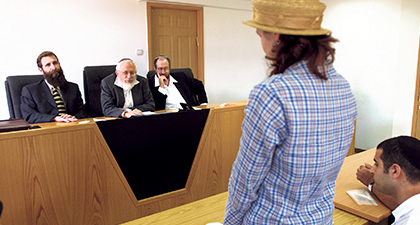In his recent CJN cover story (“Why I didn’t become a rabbi,” Feb. 18) writer Matthew Gindin presents a fascinating – although extreme – example of the spiritual struggles and journeys that many people go through. However, in my opinion, his description of his dealings with the Orthodox beit din for conversion and his criticism of the process, are misleading.
Firstly, one gets the distinct impression that Gindin’s interaction with the beit din occurred within the past few years. In fact, it didn’t. As the director of the beit din for over a decade, it surprised me that I did not remember such a unique story. When I contacted the author, he revealed to me that this part of the story goes back a dozen years. This is important information for the reader and anyone thinking of contacting the beit din.
The article also implies that the rabbis of the beit din wish to fashion a monolithic group of converts created in their own image. This is far from the truth. An informal survey of people recently going through the conversion process reveals individuals belonging to Ashkenazic, Sephardic, hasidic, modern Orthodox, “black hat” and Chabad congregations. One young woman, for example, made aliyah and is living in a Mizrachi community, while another married a shtreimel-wearing Hasid. Each convert is free to choose his or her own path within Judaism.
Like any organization that provides a service to the community, it’s impossible for the beit din to make everyone happy. One person may be impatient with the time element involved and another frustrated by the halakhic requirements. There can sometimes be misunderstandings, too. And, there are complex situations that require difficult decisions. We try to deal with people fairly and respectfully. The rude and negative treatment described by Gindin is unlike anything I have witnessed in beit din over the past decade.
READ: WHY I DIDN’T BECOME A RABBI: A MAN’S JOURNEY IN DISCOVERING HIS JEWISH ROOTS
It is also difficult to believe that my predecessor ignored him when he “tried repeatedly to talk to him.” This is inconsistent with both his nature and his reputation. It certainly would not have been for ideological reasons. The director at the time received his ordination from Yeshiva University and was the spiritual leader of a modern Orthodox congregation. He has since made aliyah and is the Israeli representative of the Rabbinical Council of America, a body which represents non-haredi Orthodox rabbis.
That said, there can be no argument with the article’s premise that the beit din maintains certain standards. It is precisely the existence of a consistent set of rules that has ensured the survival of the Jewish people for over three millennia. A community that stands for everything, stands for nothing. For Gindin to conclude that the “rabbis could not be trusted to follow the will of God and the intent of the Torah” is absurd and insulting. He is attacking leading Orthodox rabbis of Toronto, respected as experts in Jewish law by thousands of Jews across Canada and beyond.
“IT’S IMPOSSIBLE FOR THE BEIT DIN TO MAKE EVERYONE HAPPY”
Mr. Gindin sought advice from a yeshiva in New York that aligns itself with what he describes as “progressive Orthodoxy.” If he did not feel that our beit din fit in with this philosophy, he could have found another one that did. Instead, he chooses to denigrate an institution that is part of mainstream Orthodoxy for not fitting into his vision. Clearly, that is both close-minded and disrespectful.
Like any journey, a spiritual one can take many twists and turns and lead the traveller to unexpected destinations along the way. If the voyager doesn’t appreciate the local customs in any of these places, he or she doesn’t have to adopt or approve of them. However, there is a civil and polite way of dealing with those you disagree with. That can make the excursion a learning experience, a way of understanding where others are coming from and an opportunity for building bridges.
